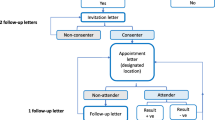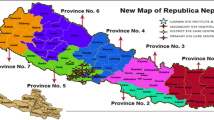Abstract
Objective
Diabetic retinopathy is one of the leading causes of vision impairment among adults in the USA. While it is suggested that diabetics receive annual dilated fundus examinations (DFE), many patients do not adhere to these recommendations. This paper investigates the outcomes and costs of an educational and telephone intervention on DFE follow-up adherence in patients with diabetes.
Methods
In a prospective trial, 356 diabetic patients due for a DFE at an urban eye clinic were randomly assigned to usual care (UC; reference case), mailed intervention (MI), or telephone intervention (TI). UC patients (n = 119) received a standard form letter. MI patients (n = 117) received a personalized letter encouraging scheduling of an eye examination with an educational brochure about diabetic eye disease. TI patients (n = 120) received personal calls (up to three attempts) to schedule a follow-up with standard form letter. The primary outcome was obtaining a DFE within 90 days of suggested return. Costs (US$ 2013) included time costs for staff, phone charges, supplies, and postage. Since TI involved greater cost components compared to MI, univariate sensitivity analysis examined the impact of reducing phone costs.
Results
Patients were mostly female (66 %) and African American (70 %) with a mean age of 61 years. TI patients were more likely to schedule DFE [65 vs. 42 %; relative risk (RR) 1.54; CI 1.20–1.96; P < 0.001] versus UC patients. Obtaining a DFE within 90 days of suggested return was also significantly higher among TI patients compared to UC patients (51 vs. 36 %, RR 1.41; CI 1.05–1.89; P = 0.024). MI patients were slightly less likely to schedule DFE versus UC patients (38 vs. 42 %, RR 0.90; CI 0.66–1.22; P = NSS) and obtain a DFE (32 vs. 36 %; RR 0.90; CI 0.63–1.28; P = NSS). The total cost of TI was US$798.28 or US$6.65/patient and the cost/follow-up DFE was US$26.05. Sensitivity analyses revealed that the cost/follow-up can be greatly reduced but remains greater compared to UC (US$2.76 if US$0.25/call, US$11.13 if $1/call; US$22.29 if US$2/call).
Conclusions
Personal phone assistance in scheduling DFE follow-up is more effective but also more costly. Follow-up research has been initiated to determine whether automated phone reminders can achieve similar effectiveness at a lower cost.




Similar content being viewed by others
References
Kempen JH, O’Colmain BJ, Leske MC, et al. The prevalence of diabetic retinopathy among adults in the United States. Arch Ophthalmol. 2004;122:552–63.
Vitale S, Cotch MF, Sperduto RD. Prevalence of visual impairment in the United States. JAMA. 2006;295(2158):2163.
Klein BE. Overview of epidemiologic studies of diabetic retinopathy. Ophthalmic Epidemiol. 2007;14:179–83.
Frank RN. Diabetic retinopathy. N Engl J Med. 2004;350:48–58.
Ferris FL 3rd. How effective are treatments for diabetic retinopathy? JAMA. 1993;269:1290–1.
Javitt JC, Aiello LP. Cost-outcomes of detecting and treating diabetic retinopathy. Ann Intern Med. 1996;124:164–9.
Javitt JC, Aiello LP, Chiang Y, Ferris FL 3rd, Canner JK, Greenfield S. Preventive eye care in people with diabetes is cost-saving to the federal government. Implications for health-care reform. Diabetes Care. 1994;17:909–17.
Sloan FA, Picone G, Brown DS, Lee PP. Longitudinal analysis of the relationship between regular eye examinations and changes in visual and functional status. J Am Geriatr Soc. 2005;53:1867–74.
Vijan S, Hofer TP, Hayward RA. Cost-utility analysis of screening intervals for diabetic retinopathy in patients with type 2 diabetes mellitus. JAMA. 2000;283:889–96.
Diabetic Retinopathy Summary Benchmark O.N.E. Network: American Academy of Ophthalmology. 2008. http://one.aao.org/CE/PracticeGuidelines/SummaryBenchmark.aspx?cid=ea5c6d25-2ab9-4398-b00b-8efcb8cc5bc7. Accessed 15 Nov 2013.
American Diabetes A. Diabetic retinopathy. Diabetes Care. 2000;23(Suppl 1):S73–6.
Murchison AP, Dai Y, Leiby B, et al. Eye care utilization by patients with diabetes: a retrospective analysis targeted to improve follow-up adherence. In: Session presentation at the American Public Health Association 140th Annual Meeting and Expo, San Francisco. 2012.
Murchison A, Hark LA, Haller JA, et al. Access to eye care by patients with diabetes: a retrospective analysis. In: Research symposium presentation at the Association for Research in Vision and Ophthalmology (ARVO) 2012 Annual Meeting, Fort Lauderdale. 2012.
Zangalli C, Murchison A, Hale N, et al. Educational and personal reminders to improve follow-up to vision care in patients with diabetes. In: Research symposium presentation at the Association for Research in Vision and Ophthalmology (ARVO) 2013 Annual Meeting, Seattle. 2013.
Zangalli C, Hale N, Dai Y, et al. Effectiveness of a clinic-based intervention to improve follow-up adherence to vision care in patients with diabetes. In: Session presentation at the American Public Health Association 141st Annual meeting and Expo, Boston. 2013.
Occupational Employment And Wages—May 2012. Bureau of Labor Statistics Web site. 2013. http://www.bls.gov/news.release/archives/ocwage_03292013.pdf. Accessed 15 Aug 2013.
United States Postal Service Price List (Notice 123), January 27, 2013. 2013. http://www.umsmail.com/about/..%5Cimages%5CUSPS_newrates.pdf. Accessed 20 Aug 2013.
Anderson RM, Musch DC, Nwankwo RB, et al. Personalized follow-up increases return rate at urban eye disease screening clinics for African Americans with diabetes: results of a randomized trial. Ethn Dis. 2003;13:40–6.
Walker EA, Schechter CB, Caban A, Basch CE. Telephone intervention to promote diabetic retinopathy screening among the urban poor. Am J Prev Med. 2008;34:185–91.
Schechter CB, Basch CE, Caban A, Walker EA. Cost effectiveness of a telephone intervention to promote dilated fundus examination in adults with diabetes mellitus. Clin Ophthalmol. 2008;2:763–8.
Basch CE, Walker EA, Howard CJ, Shamoon H, Zybert P. The effect of health education on the rate of ophthalmic examinations among African Americans with diabetes mellitus. Am J Public Health. 1999;89:1878–82.
Zhang X, Saaddine JB, Lee PP, et al. Eye care in the United States: do we deliver to high-risk people who can benefit most from it? Arch Ophthalmol. 2007;125:411–8.
Acknowledgments
This study was funded by the US Centers for Disease Control and Prevention grant no. 5U58DP002655-04. The authors have no conflicts of interest to disclose. The authors work was performed independently of the funders.
Author contributions
All authors provided a substantial contribution to the writing and revision of this manuscript as well as the interpretation of findings. Pizzi, Dai, and Leiby also provided significant contribution to the data analysis. Zangalli and Hale led the implementation of the study and data collection. Murchison, Hark, and Haller provided methodological guidance and research oversight. Pizzi is the Guarantor of the overall content of this manuscript.
Author information
Authors and Affiliations
Corresponding author
Statistical Appendix: Poisson Regression Models
Statistical Appendix: Poisson Regression Models
The results presented in these tables are from Poisson regression models where the dependent variable is keeping timely appointment. Models were fit in SAS PROC GENMOD using generalized estimating equation (GEE) methods with empirical standard errors. Score tests were used to determine the adjusted association of each variable with keeping timely appointment. When a categorical variable had more than two categories, pairwise category comparisons were performed using Wald P values. Table 7 reports results for the main effects model. Parameter estimates are estimates of the log relative risk. Equivalent results on the relative risk scale for Table 7 are reported in the main text Table 3.
Rights and permissions
About this article
Cite this article
Pizzi, L.T., Zangalli, C.S., Murchison, A.P. et al. Prospective Randomized Controlled Trial Comparing the Outcomes and Costs of Two Eyecare Adherence Interventions in Diabetes Patients. Appl Health Econ Health Policy 13, 253–263 (2015). https://doi.org/10.1007/s40258-015-0159-4
Published:
Issue Date:
DOI: https://doi.org/10.1007/s40258-015-0159-4




